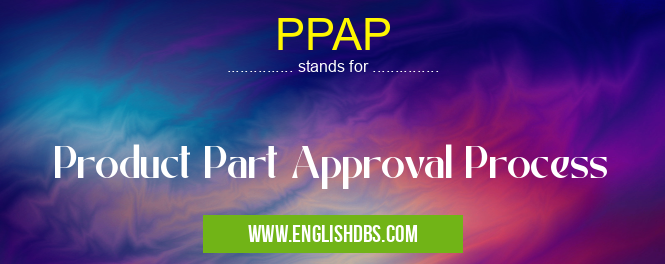What does PPAP mean in UNCLASSIFIED
PPAP stands for Product Part Approval Process. It is a set of requirements established by the automotive industry to ensure that suppliers provide parts that meet the customer's specifications. PPAP is a critical part of the quality management system for any supplier to the automotive industry.

PPAP meaning in Unclassified in Miscellaneous
PPAP mostly used in an acronym Unclassified in Category Miscellaneous that means Product Part Approval Process
Shorthand: PPAP,
Full Form: Product Part Approval Process
For more information of "Product Part Approval Process", see the section below.
What is PPAP?
PPAP is a comprehensive process that includes the following steps:
- PPAP submission: The supplier submits a PPAP package to the customer. This package contains all of the required documentation, including:
- Design records
- Process flow diagrams
- Control plans
- Inspection reports
- Test results
- PPAP review: The customer reviews the PPAP package and provides feedback to the supplier.
- PPAP approval: Once the customer is satisfied with the PPAP package, they will approve it. This approval signifies that the supplier has met all of the customer's requirements.
Benefits of PPAP
There are many benefits to using PPAP, including:
- Improved quality: PPAP helps to improve quality by ensuring that suppliers are providing parts that meet the customer's specifications.
- Reduced costs: PPAP can help to reduce costs by preventing defects and rework.
- Improved customer satisfaction: PPAP can help to improve customer satisfaction by providing them with confidence that the parts they are receiving are of high quality.
Essential Questions and Answers on Product Part Approval Process in "MISCELLANEOUS»UNFILED"
What is the Product Part Approval Process (PPAP)?
PPAP is a standardized automotive industry process for obtaining approval for production parts submitted by suppliers to original equipment manufacturers (OEMs). It ensures that parts meet customer requirements and are manufactured consistently and reliably.
What are the key steps in the PPAP process?
The key steps in the PPAP process include:
- Submission of a PPAP package
- Review and approval of the PPAP package
- Production part approval
- Post-approval monitoring
What documents are required for a PPAP package?
The documents required for a PPAP package typically include:
- Design records
- Process flow diagram
- Control plan
- Measurement results
- Dimensional layout and GD&T
- Inspection report
- Appearance approval report
- Certificate of compliance
Who is responsible for the PPAP process?
The PPAP process is a shared responsibility between the supplier and the OEM. The supplier is responsible for submitting a complete and accurate PPAP package, while the OEM is responsible for reviewing and approving the package.
What are the benefits of implementing the PPAP process?
The benefits of implementing the PPAP process include:
- Reduced risk of defects
- Improved product quality
- Increased customer satisfaction
- Reduced production costs
Is PPAP required for all automotive suppliers?
PPAP is not mandatory for all automotive suppliers, but it is highly recommended for suppliers who want to meet the quality standards of OEMs and maintain a competitive edge in the industry.
Final Words: PPAP is a critical part of the quality management system for any supplier to the automotive industry. It is a comprehensive process that helps to ensure that suppliers are providing parts that meet the customer's specifications. PPAP can help to improve quality, reduce costs, and improve customer satisfaction.
